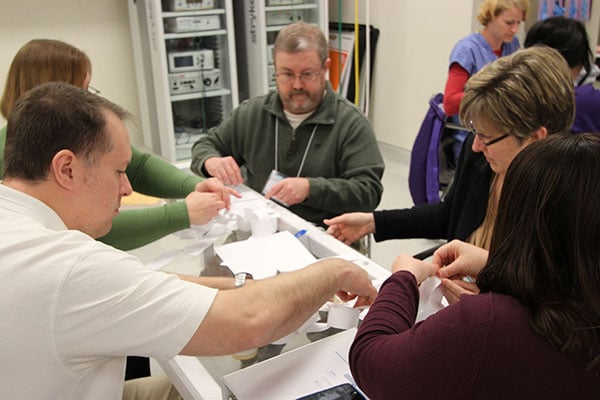This team communication learning activity is intended for educators and students. This is a great exercise to introduce or review TeamSTEPPS® skills in a fun, simple format. Educators can use this to set the stage for comprehensive interprofessional simulation team training sessions or role-play activities with students or as an example of a TeamSTEPPS® training exercise during educator/facilitator training. This learning activity is divided into three activities, each progressively more complex. Facilitators may choose to run two or all three of the activities depending upon time constraints.

Learning Objectives:
The objective is for trainees to learn and use TeamSTEPPS® team communication skills without knowing it as they build paper chains with as many loops as possible. These activities highlight the need for strong team communication and introduces TeamSTEPPS® concepts at many levels.
Activity 1 is aimed at covering basic (100 Level) skills: Requests, Cross-Checks, Check-Backs, Call Outs, and SBAR; introducing how to conduct a Debrief; and basic leadership skills.
Activity 2 is aimed at covering intermediate (200 Level) skills: conducting a Debrief; introducing the concept of Situational Awareness; and discussing communications skills: Briefs, Debriefs, Huddles, Handoffs and SBAR.
Activity 3 is aimed at covering advanced (300 Level) skills: conducting a Brief; discussing concept of Mutual Support; and discussing communications skills: CUS, 2‐Challenge Rule and DESC‐It.
Materials and Supplies
Flip chart or dry erase board
Markers (for flip chart or dry erase board)
Packet for Activity 1 (one per group):
- 1 pair of scissors
- 2 rolls of tape (with dispensers)
- Stack of plain paper (same number of sheets per group)
- Large envelope to contain materials
Packet for Activity 2 (one per group):
- 1 pair of scissors
- 2 rolls of scotch tape (with dispensers)
- Stack of plain paper
- 10 strips of pink paper (about 1” thick)
- 10 strips of blue paper (about 1” x thick)
- Activity 2 Algorithm (optional if projecting algorithm on screen)
- Large envelope to contain materials
Packet for Activity 3 (one per group):
- 1 pair of scissors
- 2 rolls of scotch tape (with dispenser)
- Stack of plain paper
- 10 strips of pink paper (about 1” thick)
- 10 strips of yellow paper (about 1” thick)
- 10 strips of blue paper (about 1” thick) with either a red or green dot clearly marked on the strip.
- Algorithm for Activity 3 (optional if projecting algorithm on screen)
- Large envelope to contain materials
TeamSTEPPS® Condensed Glossary (pdf)
Paper Chain Team Exercise Instructions (pdf)
TeamSTEPPS® Debrief Guide (pdf)
Instructions
To set up, arrange tables throughout the room to seat four to six participants each.
Split students or educators into interprofessional groups of 4 to 6 individuals. Each team receives closed packets of materials for the activities and are instructed not to open the packets until directed to do so by the facilitator(s).
Facilitators may provide instructions to participants either by projecting them on a screen or by providing paper copies of paper chain building algorithms in the packets.
The facilitator(s) will conduct a debrief after each activity, as described in the Paper Chain Team Exercise Instructions. Following the last activity, the facilitator(s) will conduct a longer debrief as described in the TeamSTEPPS® Debrief Guide.
Acknowledgements
This paper chain training exercise was developed by the WWAMI (Washington, Wyoming, Alaska, Montana and Idaho) Institute for Simulation in Healthcare (WISH) at the University of Washington with grant funding from the Josiah Macy Junior Foundation.
The Agency for Healthcare Research and Quality (AHRQ) and the Department of Defense (DoD) developed TeamSTEPPS®, an evidence-based set of teamwork tools aimed at optimizing patient outcomes by improving communication and teamwork skills among health care professionals. For more information about TeamSTEPPS®, visit https://www.ahrq.gov/teamstepps/index.html.
